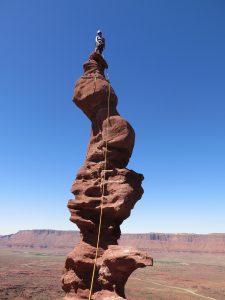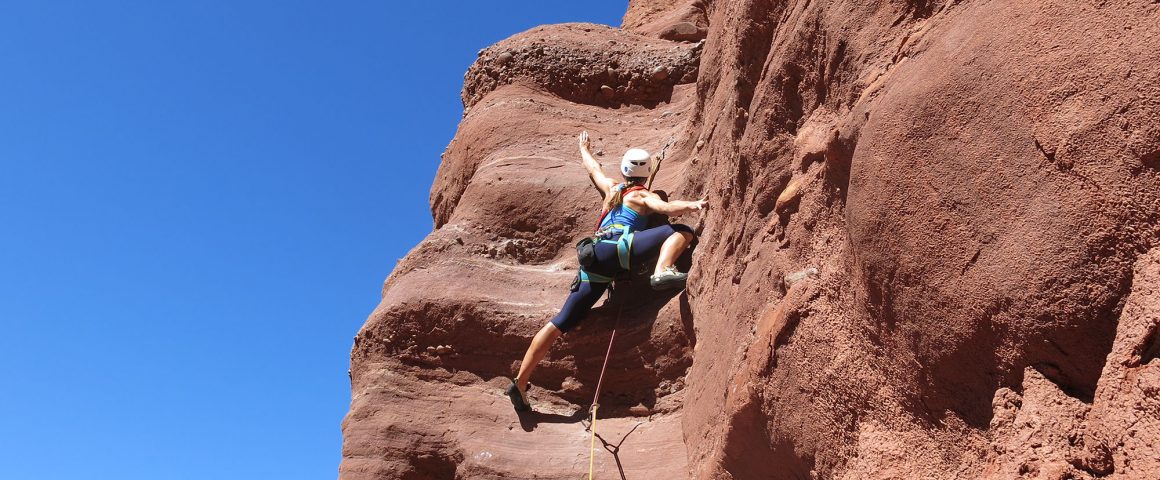By Melissa Thomas
At the top of Rich and my hitlist on a recent month-long climbing/hiking/canyoning adventure to the American southwest, was summiting some of the desert towers near the adventure capital of Moab, Utah. We’d picked late August to ensure the passes into Yosemite wouldn’t be blocked by snow, however this also meant plenty of heat in the desert.
 Moab is an oasis, a gem of the desert. The locals are warm, friendly and welcoming; all involved in some kind of outdoor addiction. No matter the time of day, there are always folk decked out in mountain biking, hiking and climbing gear, on their way out or back from an adventure. We arrived into Moab a little worse for wear, having spent the past week camped out in the Utah desert; our only method of getting clean being the occasional dunking in muddy canyon pools. No one seemed to mind that we hadn’t had time to shower and change. Instead they just grinned knowingly and asked how our day was.
Moab is an oasis, a gem of the desert. The locals are warm, friendly and welcoming; all involved in some kind of outdoor addiction. No matter the time of day, there are always folk decked out in mountain biking, hiking and climbing gear, on their way out or back from an adventure. We arrived into Moab a little worse for wear, having spent the past week camped out in the Utah desert; our only method of getting clean being the occasional dunking in muddy canyon pools. No one seemed to mind that we hadn’t had time to shower and change. Instead they just grinned knowingly and asked how our day was.
Our first desert tower would be the spectacular and tenuous Ancient Art, via a route known as ‘Stolen Chimney’. Standing atop the corkscrew summit of Ancient Art is ‘the’ quintessential desert tower summit photo that every climber dreams of. It’s a short drive from Moab along the Colorado River to the Fisher Towers, home of Ancient Art. Knowing that the climb is very popular, we chose to climb at midday; surely no-one else would be crazy enough to climb in 38C+ degree heat, right?
We arrived to a surprisingly full car park, however our fear of joining a queue of other climbers quickly dissipated when we realised everyone was far too nicely dressed; they were here for a wedding. We threw on our packs and headed down a dusty desert path, meandering through boulders and around unusual desert rock features for 15-20 minutes. Examining the ‘rock’, the first seeds of doubt began to form in my mind:
“Hey, this isn’t rock, its just tightly packed dirt! Do cams even work in dirt?”
Without any shade or breeze it was sweltering and by the time we reached the base of the route our clothes were saturated. We crouched behind a waist high boulder to gain some respite from the direct sunlight, and sorted our gear. We gazed-up, inspecting the route and visualising the line we’d take, scanning the soft red-brown rock for potential protection placements. Stolen Chimney is four pitches, graded Yosemite Decimal System (YDS) 5.10 (roughly Aussie grade 18), equipped with very friendly bolts in the two crux sections, offering a reduced grade 16 difficulty by pulling on the bolts.
We began the first pitch through a short section of broken easy ground to access the base of the climb proper, followed by a line of four bolts up a shallow half-moon vertical groove. This required delicate balance and stemming, inching our feet up on either side one-by-one while our hands danced across the course desert sandstone, using only friction, given the absence of any holds. I pressed my palms outwards for counter pressure and perspired into the soft rock. The close proximity of each bolt was of great comfort. At the third bolt I found some hand-holds: a couple of small stones embedded into the desert sand a million years ago. While small, these small indentations in the rock are enough to hold my weight and I was able pull myself onto a ledge at the base of the chimney.
Looking up at the 40-metre second pitch I was glad to be back on belay. We were about to get our first taste of climbing on compressed dirt! I anxiously watched Rich lead up into the featured chimney, and was showered at every move with dust and grit.
“Plenty of holds, it’s not as bad as it looks,” he calls down to me.
I wasn’t so sure. He lead the pitch well, finding placements that made the most of the rock while avoiding most of the dirt. As I climbed, I was reminded of climbing at the gym; hand and footholds were obvious, smoothly packed dirt by the countless climbers before us. If it wasn’t for the corkscrew summit high above, I doubt this chimney would have climbed nearly as often.
The short third pitch was reminiscent of the first; closely positioned ring-bolts leading up a short, 1.5-metre-wide buttress. Now the real exposure would begin.
We sat together on top of the buttress, attached to the rap rings, contemplating the tower in front of us. My stomach was filled with butterflies.
“Rich, it’s your lead.” I had lead the last, well protected, pitch. Thank goodness I was thinking. I did not want to be climbing first. Rich made his way across the one metre-wide boardwalk towards the final corkscrew tower. A hundred metre plus sheer drop on either side.
The tower has three bolts, although one was little more than a bit of metal bashed into a break in the rock. Protection at the summit are a tangle of old slings looped lazily around the circumference of the tower a meter or so below the summit. As I sat and watched Rich stand on the tiny corkscrew summit I doubted whether I could do the same. I felt like I would be a withering mess, koala hugging the top for dear life.
Of course, watching someone else lead something scary looking is always way worse than doing it yourself. I headed out onto the boardwalk, unable to prevent myself from gazing down at the exposure just a few centimetres either side of my feet. However, once across the boardwalk, everything was focused back on the climbing.
It always amazes me how much climbing absorbs your attention. You don’t think about anything else, just living in the moment and solving the puzzle in front of you. Entirely focused on the next few metres of climbing, with just the simple question of where to place your foot, how to position your body and what to use for the next hold become your sole focus. I was lost in this zone, as I made my way up the tower.
And then suddenly before my eyes, the tangled mess of multi-coloured slings; I was at the summit. I scrambled up to the top and even managed to stand upright and take in the view. It was incredible. I gently tiptoed a pirouette, floating above the surrounding desert on a piece of rock about 50 centimetres in diameter. The view and position was just amazing, a glimpse into what a bird experiences: the soft breeze, empty skies and endless horizons.
After getting our fill we headed down, impossible to wipe the smiles off our faces. A great morning, we even had time afterwards to drive into Arches National Park at explore some lesser known summits before finding a spot to enjoy the sunset.
This story originally appeared in issue 160. In Wild issue 161, read Part 2 of Mel and Rich’s second tower climb, on nearby Castleton Tower. Subscribe today.


